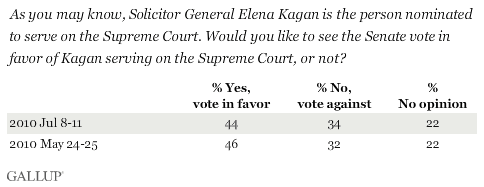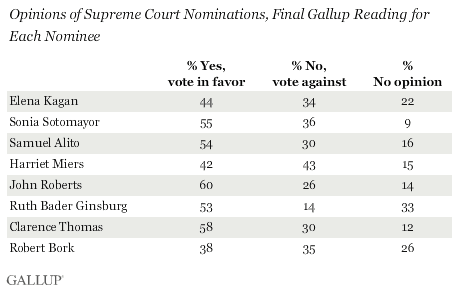PRINCETON, NJ -- More Americans want the Senate to vote for rather than against Elena Kagan's nomination to the Supreme Court, but the percentage in favor is less than a majority. Support for Kagan's confirmation remains essentially the same as it was before her June confirmation hearings.

Typically, support for nominees does not change much after their hearings. Instead, Gallup usually finds increases in the percentage of Americans opposed and decreases in the percentage with no opinion. The percentage without an opinion on the Kagan nomination was the same before and after her hearings, which may indicate these were not widely followed by the average American.
The Senate Judiciary Committee will vote on Kagan's nomination next week, with the full Senate voting later this summer. Kagan is expected to be confirmed, given the Senate's large Democratic majority.
Among the general public, a majority of self-identified Democrats, 68%, favor Kagan's confirmation, compared with 43% of independents and 21% of Republicans. A majority of Republicans, 60%, are opposed.
If confirmed, Kagan would be the first successful nominee in recent years whose nomination was backed by less than a majority of Americans in the final poll before the Senate confirmation vote (or, in the case of Harriet Miers, before her nomination was withdrawn).

In addition to Miers, Robert Bork is the other recent nominee whose support was less than 50%; the Senate voted against his nomination. Though Kagan's support, like that of Bork and Miers, is below 50%, Americans were more divided in their views of Bork and Miers. Also, Samuel Alito's support dipped to 49% after his nomination, but recovered to 54% just before his Senate confirmation vote.
Results for this Gallup poll are based on telephone interviews conducted July 8-11, 2010, with a random sample of 1,020 adults, aged 18 and older, living in the continental U.S., selected using random-digit-dial sampling.
For results based on the total sample of national adults, one can say with 95% confidence that the maximum margin of sampling error is ±4 percentage points.
Interviews are conducted with respondents on landline telephones (for respondents with a landline telephone) and cellular phones (for respondents who are cell phone-only). Each sample includes a minimum quota of 150 cell phone-only respondents and 850 landline respondents, with additional minimum quotas among landline respondents for gender within region. Landline respondents are chosen at random within each household on the basis of which member had the most recent birthday.
Samples are weighted by gender, age, race, education, region, and phone lines. Demographic weighting targets are based on the March 2009 Current Population Survey figures for the aged 18 and older non-institutionalized population living in continental U.S. telephone households. All reported margins of sampling error include the computed design effects for weighting and sample design.
In addition to sampling error, question wording and practical difficulties in conducting surveys can introduce error or bias into the findings of public opinion polls.
View methodology, full question results, and trend data.
For more details on Gallup's polling methodology, visit https://www.gallup.com/.
